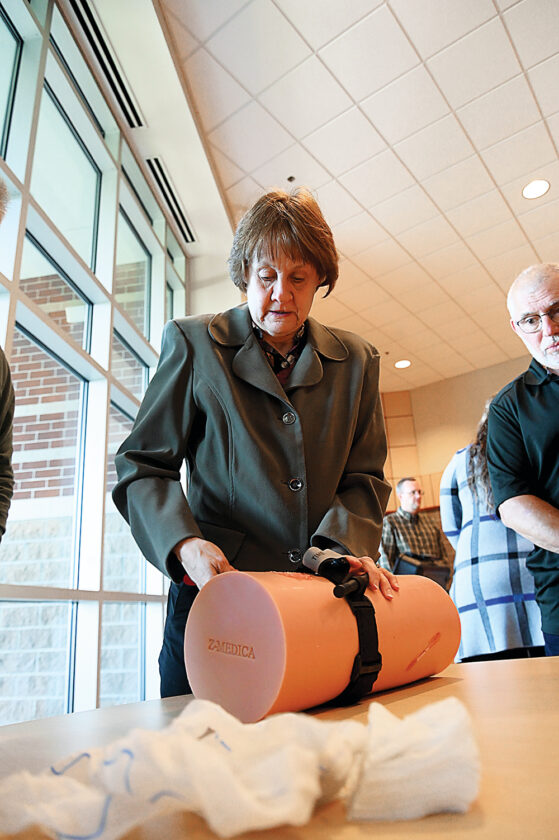Blood
Life-saving summit: Attendees learn measures to stop blood flow from serious injuries
Attendees learn how to apply a tourniquet as part of the Blair County Local Emergency Planning Committee’s annual SARA Summit at the Convention Center on Thursday.
Mirror photo by Patrick Waksmunski
The pictures that UPMC Altoona trauma educator Amy Stayer showed at the Blair County Emergency Management Committee’s annual “SARA Summit” Thursday were not for the squeamish.
She started with gaping wounds to arms and legs and progressed to severed limbs in an effort to illustrate the importance of stopping the flow of blood from serious injuries — and the need for regular people, like some of the attendees, to take such steps when medical professionals aren’t around.
Doing it quickly and doing it right are critical for victim survival, according to Stayer, one of several presenters on safety matters for an audience that included representatives of businesses that handle hazardous materials and report on them to the LEPC — as required by the Superfund Amendments and Reauthorization Act (SARA) — along with first responders and others charged with keeping the community safe.
Bleeding patients can die in minutes, and ambulance workers aren’t necessarily going to arrive in time to save someone who’s been in a car crash, a lawnmower accident or who’s been shot, according to Stayer.
Arterial bleeding can result in death within three minutes.
Cheryl Johnson of Private Industry Council of the Central Corridor in State College learns how to apply a tourniquet as part of the Blair County Local Emergency Planning Committee’s annual SARA Summit at the Convention Center on Thursday.
Mirror photo by Patrick Waksmunski
Serious bleeding from an extremity is the most frequent cause of preventable death from injury, Stayer said.
But anyone can provide the help necessary, she said.
“No one should die from uncontrolled bleeding,” Stayer said, restating the “Hartford Consensus” — a conclusion drawn at a meeting in Connecticut of the Joint Committee to Increase Survival from Active Shooter and Intentional Mass Casualty Events, whose members also recommended the widespread dissemination of knowledge on bleeding control.
People confronted with a situation that includes someone bleeding from a serious wound should remember the acronym THREAT, according to Stayer.
THREAT represents:

The Associated Press
/
Capt. Bill Deters (left) and Assistant Chief Jon Isenberg of the Williamsburg Area Volunteer Fire Company rope rescue team pack up equipment displayed at the Blair County Local Emergency Planning Committee’s annual SARA Summit at the Convention Center on Thursday.
Mirror photo by Patrick Waksmunski
— Threat suppression.
— Hemorrhage control.
— Rapid Extrication to safety.
— Assessment by medical providers.
— Transport to definitive care.
In practice, that calls for ensuring one’s own safety first, then calling 911, then identifying the injury and stopping the bleeding, according to Stayer.
Stopping blood loss may require removal of clothing that hides the injury, according to the presentation.
Bleeding in the arms and legs call for direct pressure and/or a tourniquet.
Bleeding from “junction wounds” of the neck, shoulder or groin call for packing — preferably with a hemostatic dressing saturated with a clotting component — and pressure.
Internal bleeding can’t be managed outside the hospital and thus calls for getting the victim to the hospital as quickly as possible.
In general, to stop bleeding, apply pressure first; if that doesn’t work and the wound is in an extremity, apply a tourniquet; but if the wound is at a junction, then pack the wound and apply pressure.
A manufactured tourniquet is far superior to a jury-rigged one created from a belt or shirt, according to Stayer.
Manufactured tourniquets are straps with velcro that include a “windlass rod” that the applicator twists to create high pressure, afterwards locking the rod into a slot or clip, which is then protected by a velcro strap.
Tourniquets need to be applied a short distance — the width of two fingers is best — above the wound, Stayer said.
It must not be applied over a joint.
It will hurt the victim.
“They will scream, and they will holler,” Stayer said.
The pain is 10 to 20 times as bad as the discomfort from a blood pressure cuff, Stayer said.
Once applied, a tourniquet must not be released, she said.
Don’t release it periodically to allow blood flow to the limb below the wound, because that will only “pop the clot” that is starting to form and aggravate the blood loss, she said.
It takes five hours for a limb to be lost for lack of blood flow, she said.
“Only a physician or EMS under physician instruction should loosen or remove a tourniquet,” Stayer said.
Packing a wound, like a junction wound, should be done with one or more fingers or the thumb, she said.
Don’t try to remove anything in the wound like particles of leaf or a twig — or a bullet.
Push the packing in all directions within the wound.
It’s kind of like making the sign of the cross within the wound, Stayer said.
After packing the
wound, compress firmly and hold, she said.
Plain gauze can be used, or even a shirt — if hemostatic packing isn’t available.
When using hemostatic packing, holding for three minutes should be enough.
When using some other packing material, hold for 10 minutes.
Keeping a victim warm is also critical, Stayer said.
It’s easier to prevent heat loss than to treat it after it happens, she said.
All attendees received a bag with a manufactured tourniquet and a package of hemostatic packing.
Mirror Staff Writer William Kibler is at 814-949-7038.

